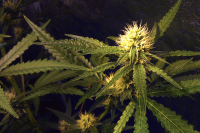Ironwood is piquing the interest of WNC residents
 There seems to be an upsurge of interest in ironwood in Western North Carolina of late. It’s curious how reader interest in certain subjects will pop up all at once, after being non-existent for years or forever. Some sort of synchronicity, I suppose.
There seems to be an upsurge of interest in ironwood in Western North Carolina of late. It’s curious how reader interest in certain subjects will pop up all at once, after being non-existent for years or forever. Some sort of synchronicity, I suppose.
Within the past month I’ve had four queries about ironwood aka muscle wood. One came from a fairly young fellow who stopped me in the grocery store at the ice cream freezer while I was trying to decide between raspberry and fudge ripple. Another was in the line at the post office, where the person ahead of us also joined in the discussion and knew more than I did about ironwood. I didn’t ask, but I’d guess he was a logger or maybe a surveyor. The fourth was via an email from Ann Bennett in Macon County, who wrote:
Dear George,
Several years ago I wrote and described a “fruit” on a plant here in our area. And you told me it was an “oil nut” or “buffalo nut.” And I thank you for that answer. Recently our two younger sons were splitting some wood that had been given them for heating purposes and they came across some very difficult logs. Some one told them the wood was Iron Wood. Is there such a tree? Is that wood from another kind of tree but has grown in such a way that makes it so hard to split?
To which I replied:
Hi Ann ... there is a shrub or small tree named ironwood (Carprinus carolinana) that is very hard. Some refer to it as “muscle wood” because it has gray skin-like bark and a muscular appearance. It’s fairly common in my experience along streams and is known for its toughness. So there’s a good chance that’s what your sons were trying to split. Sycamore, a larger tree I’m sure you are familiar with, has scaly plate-like bark, is cross-grained which makes it hard to split, too. But I’d bet on ironwood.
Related Items
Given the rising interest in ironwood I figured I’d best conduct some extra-curricula research. So, I went to a web site that I recently discovered. If you’re interested in anything having to do with trees, shrubs and vines (that is, woody plants), this is one of the places to go, especially in regard to germinating seed and propagation. I must admit that, in part, this column on ironwood is really motivated as a way to let readers know about the web site.
An overview for the Woody Plant Seed Manual (F.T. Bonner and R.P. Karrfalt, eds.) published as Agriculture Handbook 727 by the USDA, reads:
This manual brings together information on all phases of seed handling and presents the results of more than 20 years of studies. Forest Service field personnel at several experiment stations and regional offices furnished a backlog of source material for treatments of individual genera. The manual consists of two main parts. Part 1 formulates general principles on the various phases of seed handling from formation of the seed to sowing. Part 2, which forms the larger part of the manual, provides relatively detailed but concise information for 444 species and varieties of trees and shrubs; this includes data on distribution and use, discussions of seeding habits, methods of seed collection, extraction and storage, seed germination, and nursery and field practice.
You can buy the soft cover edition for $78.92 or the hardcover for $110.80 or you can go online and download the entire book (or just the accounts for individual plant species) for free in various formats, including PDF at www.nsl.fs.fed.us/nsl_wpsm.html.
Here then are some brief excerpts from the Woody Plant Seed Manual regarding ironwood:
The northern American hornbeam species is divided into the subsp. caroliniana from along the Atlantic and Gulf Coastal Plains of the southeastern United States and the subsp. virginiana of the Appalachian Mountains and northern interior regions to the West. The wood of hornbeams is extremely hard — hence the common name “ironwood” — and is used for making tool handles and mallet heads. It is also used to produce the high-quality charcoal used in gunpowder manufacture. The bark on older trees is slate gray, smooth, and irregularly fluted; the overall appearance is comparable to the flexed bicep and forearm muscles — hence another common name, “musclewood.”
In case you’re wondering, after due deliberation, I decided on fudge ripple.
(George Ellison is a naturalist and writer. He can be reached at This email address is being protected from spambots. You need JavaScript enabled to view it..)









